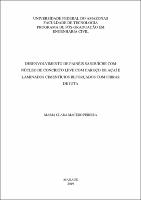| ???jsp.display-item.social.title??? |


|
Please use this identifier to cite or link to this item:
https://tede.ufam.edu.br/handle/tede/7172Full metadata record
| DC Field | Value | Language |
|---|---|---|
| dc.creator | Pereira, Maria Clara Macedo | - |
| dc.creator.Lattes | http://lattes.cnpq.br/4146065634142945 | por |
| dc.contributor.advisor1 | Melo Filho, João de Almeida | - |
| dc.contributor.advisor1Lattes | http://lattes.cnpq.br/9045456793790448 | por |
| dc.contributor.referee1 | Andrade, Jean Carlos Silva | - |
| dc.contributor.referee1Lattes | http://lattes.cnpq.br/3330175940424250 | por |
| dc.contributor.referee2 | Vasconcelos, Raimundo Pereira de | - |
| dc.contributor.referee2Lattes | http://lattes.cnpq.br/4592922524470036 | por |
| dc.date.issued | 2019-03-25 | - |
| dc.identifier.citation | PEREIRA, Maria Clara Macedo. Desenvolvimento de painéis sanduíche com núcleo leve com caroço de açaí e laminados reforçados com fibras de juta. 2019. 99 f. Dissertação (Mestrado em Engenharia Civil) - Universidade Federal do Amazonas, Manaus, 2019 | por |
| dc.identifier.uri | https://tede.ufam.edu.br/handle/tede/7172 | - |
| dc.description.resumo | No presente estudo realizou-se o desenvolvimento e caracterização mecânica de um painel sanduíche composto por núcleo de concreto leve com caroço de açaí e outro por poliestireno expandido, com faces de compósitos cimentícios reforçados com fibras longas de juta. Na produção do núcleo estudou-se três tipos de traços com dois tipos de agregados diferentes (poliestireno expandido e caroço de açaí), escolheu-se o caroço de açaí (agregado natural) visando a redução da geração de resíduo e elevação do valor agregado deste material. O núcleo foi analisado quanto a resistência mecânica, o tipo de tratamento utilizado no agregado natural e a densidade. As faces foram produzidas com o teor de 6% de fibras de juta longas, alinhadas unidirecionalmente e distribuídas em 3 camadas, formando um laminado. Os laminados e o painel sanduíche foram analisados por meio de ensaios de flexão em quatro pontos. O tratamento aliado com saturação no agregado natural acrescentou à resistência no compósito do núcleo e o tratamento com parafina ou resina reduziu em cerca de 36% a absorção de água, observou-se que a densidade do núcleo influenciou na resistência a compressão. A tensão média de ruptura dos laminados foi de 27,7 MPa com deflexão máxima de 5,10 mm. O painel sanduíche rompeu por flexão da face inferior e com carga máxima de ruptura de 3,67 KN. Com os resultados apresentados observou-se vantagens da utilização do elemento painel sanduíche no sistema construtivo e a utilização do agregado natural no núcleo tanto do ponto de vista mecânico quanto ambiental. | por |
| dc.description.abstract | In the present study, the development and mechanical characterization of a sandwich panel composed of a lightweight concrete core with açaí seed and another by expanded polystyrene, with faces of cementitious composites reinforced with long jute fibers were carried out. In the production of the core, three types of traces were studied with two types of different aggregates (expanded polystyrene and açaí seed), the açaí seed (natural aggregate) was chosen aiming the reduction of the residue generation and increase of the added value of this material. The core was analyzed for resistance range, type of treatment used in the natural aggregate and density. The faces were produced with 6% content of long jute fibers, aligned unidirectionally and distributed in 3 layers, forming a laminate. The laminates and the sandwich panel were analyzed by four-point bending tests. The treatment combined with saturation in the natural aggregate added to the strength in the core composite and the treatment with paraffin or resin reduced the water absorption about 36%, it was observed that the density of the core influenced the compressive strength. The average of tensile stress of the laminates was 27,7 MPa with an maximun deflection of 5,10 mm. The sandwich panel ruptured by bending of the lower face and the maximum rupture load was 3,67 KN. With the present results were observed advantages of using the sandwich-panel element in the construction system and the use of the natural aggregate in the core from both a mechanical and an environmental point of view were observed. | eng |
| dc.description.sponsorship | CAPES - Coordenação de Aperfeiçoamento de Pessoal de Nível Superior | por |
| dc.format | image/jpeg | * |
| dc.format | application/pdf | * |
| dc.thumbnail.url | https://tede.ufam.edu.br//retrieve/31030/Disserta%c3%a7%c3%a3o_MariaClaraPereira_PPGEC.pdf.jpg | * |
| dc.language | por | por |
| dc.publisher | Universidade Federal do Amazonas | por |
| dc.publisher.department | Faculdade de Tecnologia | por |
| dc.publisher.country | Brasil | por |
| dc.publisher.initials | UFAM | por |
| dc.publisher.program | Programa de Pós-graduação em Engenharia Civil | por |
| dc.rights | Acesso Aberto | por |
| dc.rights.uri | http://creativecommons.org/licenses/by-nd/4.0/ | - |
| dc.subject | Painel sanduíche | por |
| dc.subject | Poliestireno expandido | por |
| dc.subject | Caroço de açaí | por |
| dc.subject | Juta | por |
| dc.subject | Caracterização | por |
| dc.subject.cnpq | ENGENHARIAS: ENGENHARIA CIVIL: CONSTRUÇÃO CIVIL: MATERIAIS E COMPONENTES DE CONSTRUÇÃO | por |
| dc.title | Desenvolvimento de painéis sanduíche com núcleo leve com caroço de açaí e laminados reforçados com fibras de juta | por |
| dc.title.alternative | Development of sandwich panels with açaí seed and cementary reinforced laminate with jute fibers | eng |
| dc.type | Dissertação | por |
| dc.description.sugestao | Dificuldades encontradas com relação a falta de equipamentos na Universidade Federal do Amazonas para a realização de ensaios mecânicos voltados ao concreto | por |
| Appears in Collections: | Mestrado em Engenharia Civil | |
Files in This Item:
| File | Description | Size | Format | |
|---|---|---|---|---|
| Dissertação_MariaClaraPereira_PPGEC.pdf | 3.11 MB | Adobe PDF |  Download/Open Preview |
This item is licensed under a Creative Commons License





